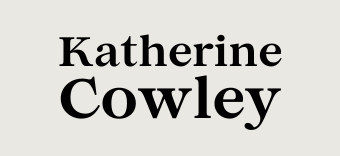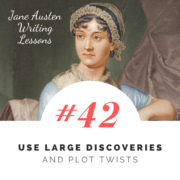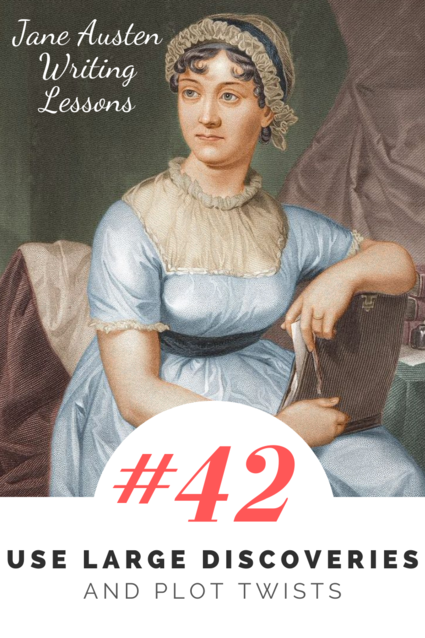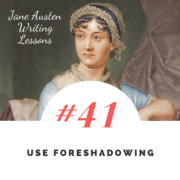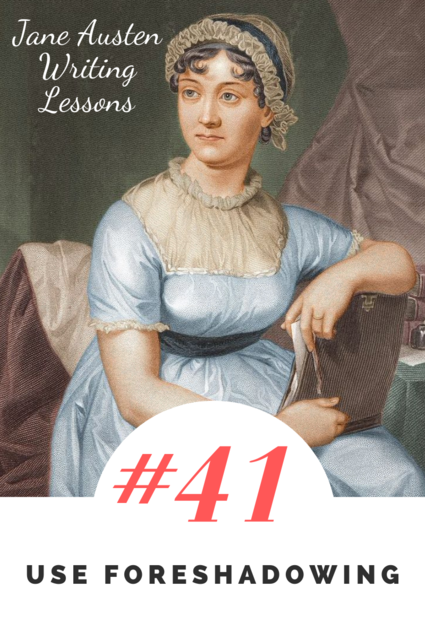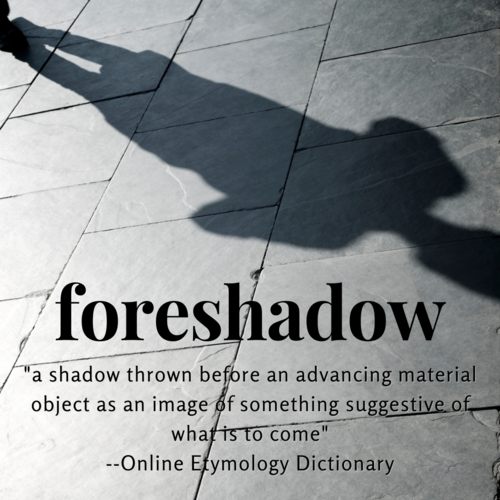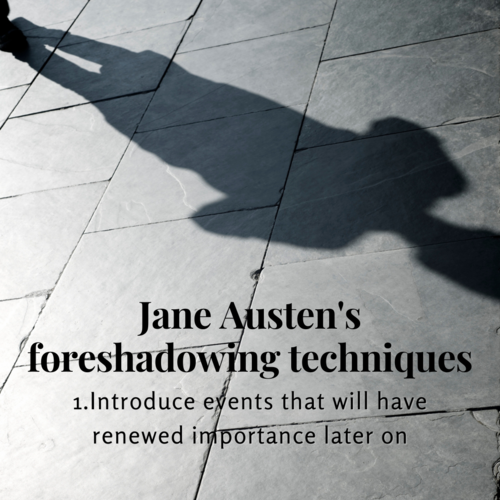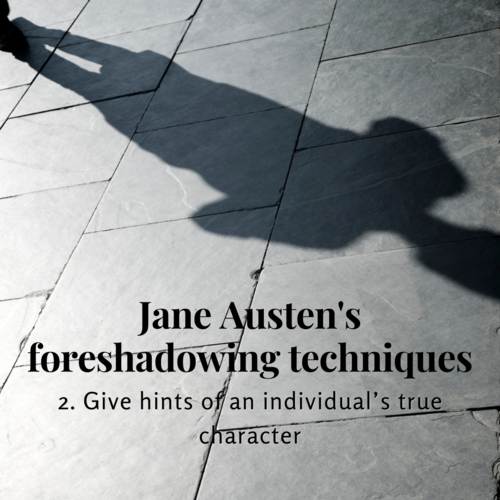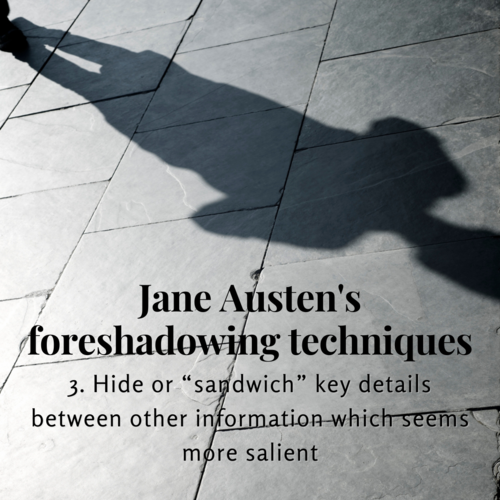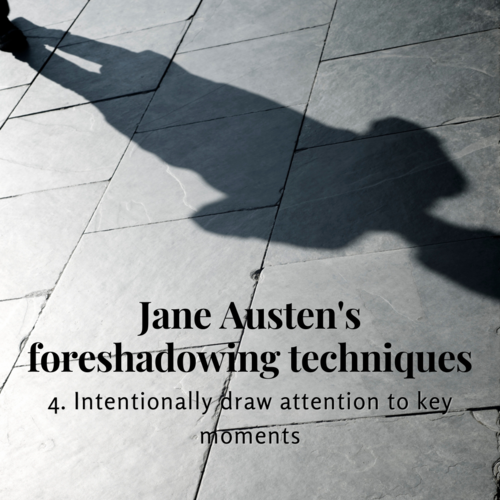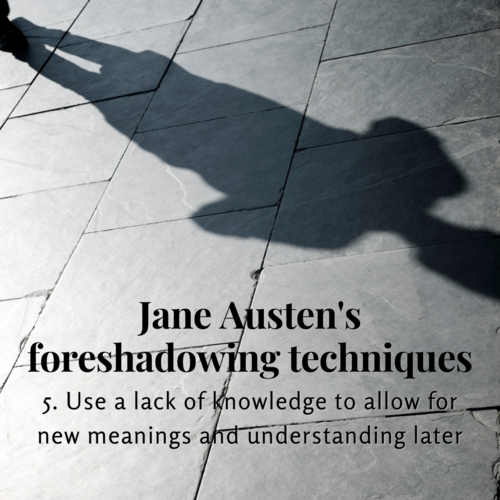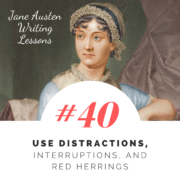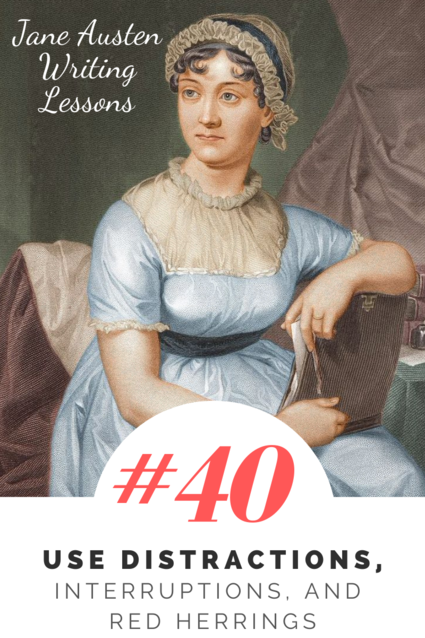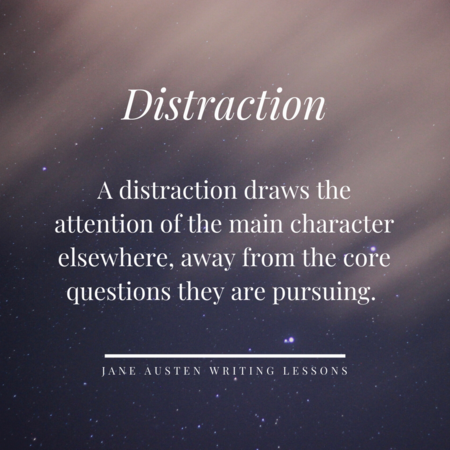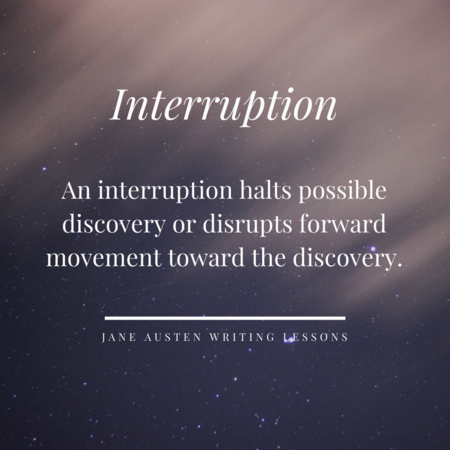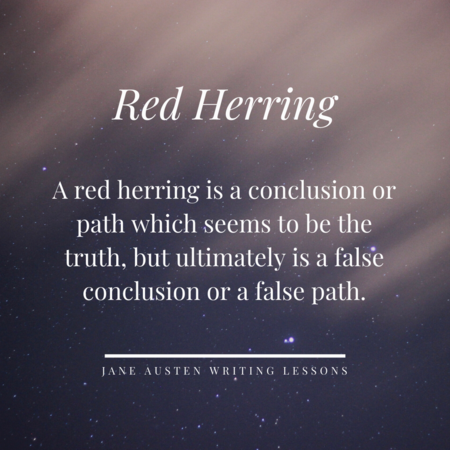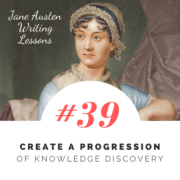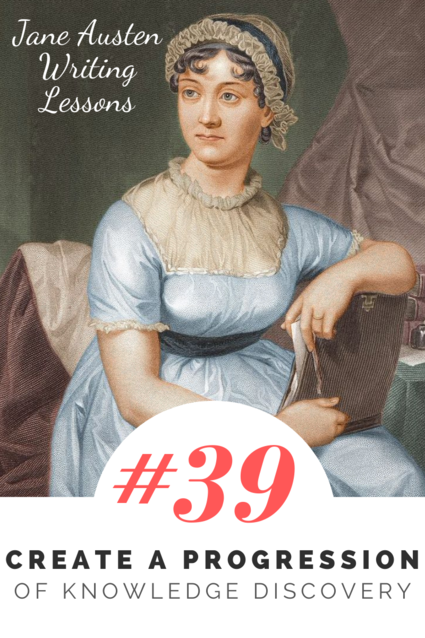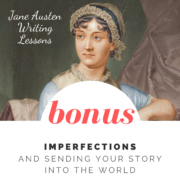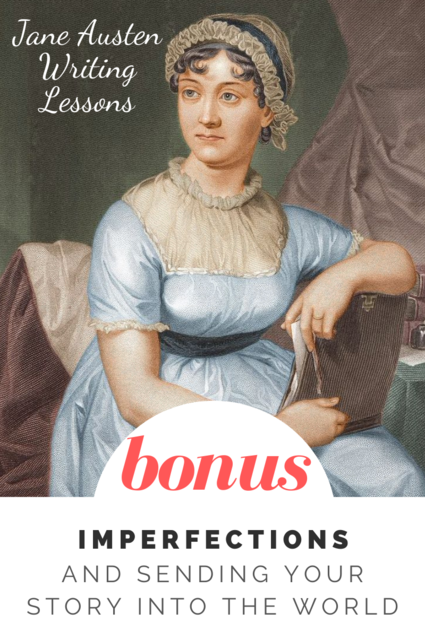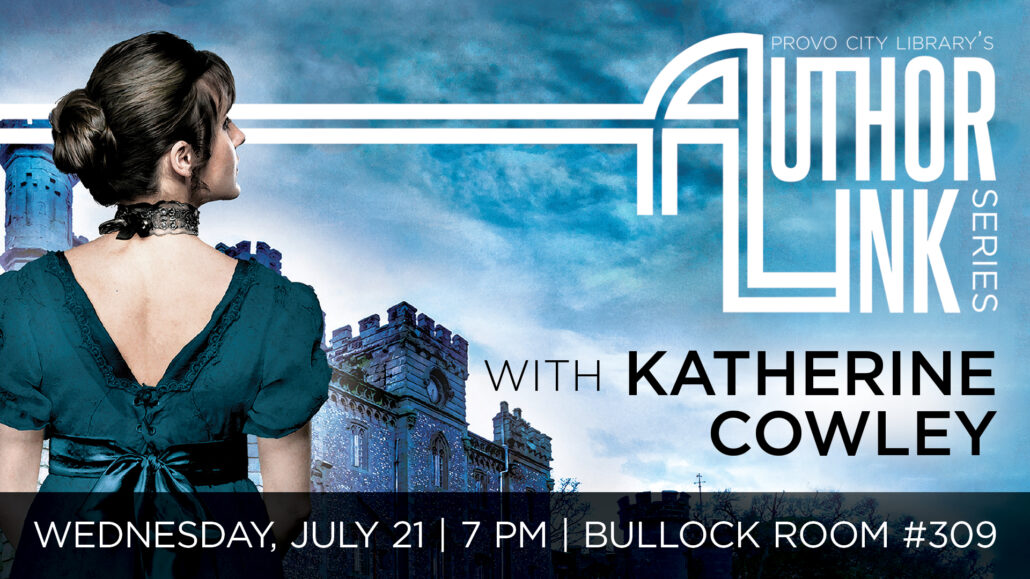#42: Use Large Discoveries and Plot Twists
Every Jane Austen novel has at least two or three large discoveries. These are grand reveals, surprise proposals, plot twists—these are moments when everything the character (and the reader) knows experiences a large shift or change. Sometimes these discoveries are unexpected for the reader, and other times, they are long hoped for by the reader (such as two favorite characters finally expressing their love to each other).
But how do you effectively write these grand discoveries? What are the essential elements?
The first element is something we discussed in the previous lesson: if there is a large discovery, there must be foreshadowing in advance. That way, even if the discovery is a surprise, it is believable and fits within the story world.
The next elements relate to the scene in which the discovery occurs. We’re going to discuss the biggest discoveries and plot twists that occur near the end of Jane Austen’s novel Emma. So prepare yourself for epic spoilers, which are necessary, or we can’t talk about how these scenes work.
The Sequence of Large Discoveries in Emma
Near the end of Emma, Jane Austen stacks four huge discoveries in a row, all near the climax of the book.
Here is the sequence of discoveries:
Discovery 1: Frank Churchill and Jane Fairfax have been secretly engaged for months.
Discovery 2: Harriet is not in love with Frank Churchill: she is in love with Mr. Knightley.
Discovery 3: Emma realizes that she herself is in love with Mr. Knightley and wants to marry him. (This discovery is one that is for the character and her character arc, but one that readers have likely suspected for quite some time.)
Discovery 4: Mr. Knightley loves Emma.
When I read Emma for the first time, I was completely surprised and blown away by the first discovery, that Frank Churchill and Jane Fairfax have been secretly engaged. I was not expecting it at all, and yet it was beautiful and horrifying and compelling and perfect and made me reconsider everything I’d read.
Other discoveries, like the third and fourth, I suspected, but that did not lessen the impact of these discoveries, because they are such key moments for the characters.
There is so much happening in each of these scenes, and they are well worth rereading. But each of these scenes contains a few core components. These are not always in the same order, and sometimes these components occur more than once within the same scene.
1. Advance signaling
Austen always builds up anticipation right before a large discovery—she gives advance signaling that there will be a large discovery.
Before Emma finds out about Frank and Jane’s engagement, Mr. Weston requests that Emma visit his house for news which only his wife can tell her, which sets off all sorts of warning signals in Emma’s head (she even worries that something has happened to her sister or brother-in-law or their children).
Before Harriet’s revelation, Emma notices that Harriet’s speech and mannerisms are not what she would expect:
It was indeed, so odd; Harriet’s behaviour was so extremely odd, that Emma did not know how to understand it. Her character appeared absolutely changed.
2. The Discovery Itself
The discovery itself is always expressed in a compelling way, whether it’s through someone’s speech, actions, events, or a combination.
When Emma discovers her own nature, her own feelings towards Mr. Knightley, we read:
Why was it so much worse that Harriet should be in love with Mr. Knightley, than with Frank Churchill? Why was the evil so dreadfully increased by Harriet’s having some hope of a return? It darted through her, with the speed of an arrow, that Mr. Knightley must marry no one but herself!
And when Mr. Knightley his love for Emma, we have some of the most romantic lines in the novel:
“I cannot make speeches, Emma. If I loved you less, I might be able to talk about it more….At present, I ask only to hear, once to hear your voice.”
3. Physical Reaction
A large discovery marks a huge shift of knowledge and understanding for a character. In cases like this, there is always some sort of physical reaction. Sometimes this is an internal reaction for the character (for example, a headache, stomach pain, etc.), and sometimes this is expressed in outward physical behavior (for example, speech, body language, movement, etc.).
After Mrs. Weston gives news of Frank and Jane’s engagement, we read:
Emma even jumped with surprise;–and, horror-struck, exclaimed,
“Jane Fairfax!—Good God! You are not serious? You do not mean it?”
Later, as Emma learns of Harriet’s true affections, we read:
[Emma] could not speak another word.—Her voice was lost; and she sat down, waiting in great terror till Harriet should answer.
4. Emotional Reaction
Large discoveries should always create an emotional reaction within the character, and as such, this emotion must be conveyed to the reader.
Emotions are conveyed throughout each of these four scenes in various ways. Here’s a passage that occurs after Emma’s discoveries of Harriet’s affection and of her own affections, which uses free indirect speech to convey emotion:
The rest of the day, the following night, were hardly enough for her thoughts.—She was bewildered amidst the confusion of all that had rushed on her within the last few hours. Every moment had brought a fresh surprise; and every surprise must be matter of humiliation to her.—How to understand it all! How to understand the deceptions she had been thus practicing on herself, and living under!—The blunders, the blindness of her own head and heart!—she sat still, she walked about, she tried her own room, she tried the shrubbery—in every place, every posture, she perceived that she had acted most weakly; that she had been imposed on by others in a most mortifying degree; that she had been imposing on herself in a degree yet more mortifying; that she was wretched, and should probably find this day but the beginning of wretchedness.
5. Reflection
Finally, large discoveries and twists demand further reflection from the character (which allows for reflection by the reader). This reflection is a chance for the character to consider the discovery in context, and to think about what this discovery means for the future.
A few minutes after the discovery of the hidden engagement, Emma reflects verbally on the discovery as she speaks to the Westons:
“Well,” said Emma, “I suppose we shall gradually grow reconciled to the idea, and I wish them very happy. But I shall always think it a very abominable sort of proceeding. What has it been but a system of hypocrisy and deceit,–espionage, and treachery?—To come among us with professions of openness and simplicity; and such a league in secret to judge us all!—Here have we been, the whole winter and spring, completely duped, fancying ourselves all on equal footing of truth and honour, with two people in the midst of us who may have been carrying round, comparing and sitting in judgment on sentiments and words that were never meant for both to hear.—They must take the consequence, if they have heard each other spoken of in a way not perfectly agreeable!”
After the final revelation—of Mr. Knightley’s love for Emma—we once again have Emma’s reflections:
What totally different feelings did Emma take back into the house from what she had brought out!—she had then been only daring to hope for a little respite of suffering;–she was now in an exquisite flutter of happiness, and such happiness moreover as she believed must still be greater when the flutter should have passed away.
Conclusion
Well-written discoveries can have a huge impact on characters, plot, and readers. When crafted with these five elements (advance signaling, the discovery, physical reaction, emotional reaction, and reflection) you can create powerful scenes that are satisfying to the reader. In the next lesson, which will be the final lesson on discovery, we will discuss using discovery to create satisfying story resolutions.
Exercise 1: Choose a large discovery that a character could have. First, write a character experiencing this discovery in a single paragraph, but still include all five elements: advance signaling, the discovery itself, physical reaction, emotional reaction, reflection. Now write a longer scene with a character experiencing this discovery, again using all five elements: advance signaling, the discovery itself, physical reaction, emotional reaction, reflection. What are the advantages and disadvantages of each version? Can you effectively tell the discovery both ways?
Exercise 2: Choose one of your favorite books that has been adapted to film. Rewatch and reread some of the scenes of discovery. How are the discoveries treated or expressed differently in book and the film?
#41: Use Foreshadowing
Jane Austen is an expert at foreshadowing. In each of her books, she leaves a trail of breadcrumbs for readers which lead up to her larger discoveries and reveals, whether it’s Mr. Darcy’s surprise proposal (set up by his glances and his attention and his conversation) or the truth about Mr. Wickham (which is hinted at in his words, behavior, and interaction). On a second read, it’s much easier to see these breadcrumbs, yet even if a reader does not recognize these clues as breadcrumbs, foreshadowing is essential for a good reading experience.
It’s easy, as a writer, to throw in something shocking or unexpected or create a huge twist. Yet readers feel cheated—the experience feels lacking and hollow—if these elements are not set up or foreshadowed properly.
Discoveries, especially large discoveries, must be earned. And this applies to any type of discovery, whether it’s a reveal, a twist, a deeper understanding of someone’s character, or the moment when a character obtains a missing piece of information. In the podcast Writing Excuses, the hosts about the importance making these sorts of discoveries “surprising yet inevitable.” Readers don’t necessarily expect these discoveries (and sometimes you don’t want them to expect these discoveries at all), but these discoveries do follow from what is in the narrative.
In this lesson, we’ll talk about five foreshadowing techniques used by Jane Austen, with examples from her first published novel, Sense and Sensibility.
The Techniques of Foreshadowing
The word foreshadowing literally means “before-shadow”: a shadow coming before. According to the Online Etymology Dictionary, “the notion seems to be a shadow thrown before an advancing material object as an image of something suggestive of what is to come.”
So how do you throw these shadows in advance? How do you suggest things without being too heavy-handed and providing the discovery earlier than needed for the character and the plot?
In her novel Sense and Sensibility, Jane Austen uses five major foreshadowing techniques:
- Introduce events that will have renewed importance later on
- Give hints of an individual’s true character
- Hide or “sandwich” key details between other information which seems more salient
- Intentionally draw attention to key moments
- Use a lack of knowledge to allow for new meanings and understanding later
We’ll see how she uses each of these techniques in Sense and Sensibility, but first, a little refresher on the novel.
Jane Austen’s novel Sense and Sensibility features a family uprooted. Two adult daughters, Elinor and Marianne, both have hopes and difficulties in their love lives. Elinor was falling in love with Edward Ferrars before they were uprooted, and it seemed that he reciprocated her affections, but he has not visited them since they moved. Marianne is beginning to fall in love with a dashing young gentleman named Willoughby; a slightly older gentlemen (think upper thirties) named Colonel Brandon favors Marianne but she is not interested in him.
Foreshadowing Technique #1: Introduce events that will have renewed importance later on
In Sense and Sensibility, Colonel Brandon organizes a large party to visit Whitehall. It’s a location of interest that he has a connection to—they could not visit it without him. Elinor and Marianne are invited, as are Sir John, Willoughby, and others.
Just a few minutes before they are to leave for Whitehall, Colonel Brandon receives a letter and announces that they must cancel the trip to Whitehall, for he must go to London immediately. He refuses to tell them what his business is, and refuses to delay his trip.
“We must go [to Whitehall],” said Sir John.—“It shall not be put off when we are so near to it. You cannot go to town till tomorrow, Brandon, that is all.”
“I wish it could be so easily settled. But it is not in my power to delay my journey for one day!”
….“You would not be six hours later,” said Willoughby, “if you were to defer your journey till our return.”
“I cannot afford to lose one hour.”
This event becomes important later on: much later in the book, we discover why Colonel Brandon has gone to London: a young girl in his charge was taken advantage of by Willoughby and is now pregnant, a fact Colonel Brandon reveals after Willoughby breaks Marianne’s heart and becomes engaged to another woman.
Clearly, this event has renewed importance thematically, for the plot, and for the characters later in the story. Yet it’s an important event as the moment as well. Directly after Colonel Brandon’s statement that he cannot delay a single hour, we read:
Elinor then heard Willoughby say in a low voice to Marianne, “There are some people who cannot bear a party of pleasure. Brandon is one of them. He was afraid of catching cold I dare say, and invented this trick for getting out of it. I would lay fifty guineas the letter was of his own writing.”
“I have no doubt of it,” replied Marianne.
This event is important within the chapter because Marianne uses it to judge between Colonel Brandon and Willougbhy. She sees Brandon’s abandoning of their party in a negative light, and sees Willoughby only in a positive light (though ironically, we find out later that it is Willougbhy’s actions that have caused the problem).
Colonel Brandon leaves, and everyone decides to drive their carriages together for pleasure. Marianne joins Willoughby in his carriage, and they soon separate from the rest of the party—for many hours. This could be a little scandalous in and of itself, but he takes her to the home he is to inherit and gives her a private tour, something that is certainly outside of the bounds of proper respectability. This is an action that leads many to assume that Marianne and Willoughby are secretly engaged.
As Jane Austen was crafting her novel, she could have had Colonel Brandon run off to London at any time—it could’ve happened off the page instead of in a scene; it could’ve been simply been mentioned by another character (“Where is Colonel Brandon?” “Oh, he had to leave for London for urgent business.”) Yet there is a power to including an event of importance on the page, in scene, with character dialogue and reactions, and this event is especially effective because it is not only important later on, but it has so much impact on the characters and the plot at the moment.
Foreshadowing Technique #2: Give hints of an individual’s true character
Ultimately, the most interesting discoveries that a character can make in a novel are those which are about the true nature or true character of both others and themselves. Characters, of course, have the possibility to change and transform; an attribute can have both positive and negative aspects, as well as positive and negative potential for the story.
In Sense and Sensibility, Willoughby is truly dashing. He’s charming and romantic, and his attention thrills Marianne.
At one point, Marianne’s mother, Mrs. Dashwood, makes comments about improvements she would like to make to the cottage, in order to make it more comfortable for their family. Willoughby passionately insists that their home is “faultless…I consider it as the only form of building in which happiness is attainable.” He flatters them and their home and earnestly tries to convince Mrs. Dashwood to not make any changes:
“Tell me that not only your house will remain the same, but that I shall ever find you and yours as unchanged as your dwelling; and that you will always consider me with the kindness which has made everything belonging to you so dear to me.”
The entire conversation makes Marianne feel all aflutter. For her it’s incredibly romantic—he speaks with the passion and language of her favorite poets and writers. Yet it hints at his character, it foreshadows his flaws and later choices. He wants to fix the Dashwoods and their home, to create permanence, as if they are a museum exhibit for him to enjoy, rather than living, changing human beings. He wants them for his own purposes and pleasures, without considering what their needs are and what they desire.
Foreshadowing Technique #3: Hide or “sandwich” key details between other information which seems more salient
From the moment since they arrived at the cottage, Elinor has been nursing her heartache, not just for her home at Norland, but also for Edward Ferrars. One day while Elinor and Marianne are taking a walk, they see a man on horseback approaching, who Marianne longingly hopes is Willougbhy, but it is not Willougbhy. It is Edward come to visit. Elinor is a little lost for words, but Marianne is all excitement for her sister. Yet all does not seem well:
He was confused, seemed scarcely sensible of pleasure in seeing them, looked neither rapturous nor gay, said little but what was forced from him by questions, and distinguished Elinor by no mark of affection.
A little later we read:
After a short silence which succeeded the first surprise and inquiries of meeting, Marianne asked Edward if he came directly from London. No, he had been in Devonshire a fortnight.
“A fortnight!” she repeated, surprised at his being so long in the same country with Elinor without seeing her before.
He looked rather distressed as he added, that he had been staying with some friends near Plymouth.
“Have you been lately in Sussex?” asked Elinor.
“I was at Norland about a month ago.”
“And how does dear, dear Norland look?” cried Marianne.
“Dear, dear Norland,” said Elinor, “probably looks much as it always does at this time of the year. The woods and walks thickly covered with dead leaves.”
“Oh!” cried Marianne, “with what transporting sensation have I formerly seen them fall! How have I delighted, as I walked, to see them driven in showers about me by the wind! What feelings have they, the season, the air altogether inspired! Now there is no one to regard them. They are seen only as a nuisance, swept hastily off, and driven as much as possible from the sight.”
“It is not every one,” said Elinor, “who has your passion for dead leaves.”
This passage has a number of salient moments: moments which are relevant and important, moments that draw our attention. First we have Edward’s reticence, which seems even more terrible to the sisters when we find out that he has been in the area for an entire fortnight—two weeks!—without calling on them. And then we have the fact that he has been to their old home, Norland, which is an essential moment for both Elinor and Marianne as they reflect on what they have lost. We can see how both sisters deal with loss and emotions differently by how they each talk about dead leaves.
Yet sandwiched in between the two weeks of Edward not calling on them and the leaves of Norland is a seemingly small, unimportant detail: “he had been staying with some friends near Plymouth.”
Yet this small detail is actual a key moment of foreshadowing, an important detail that is recalled later on, when Elinor meets Lucy Steele. For Lucy is one of the friends from Plymouth, and Lucy dramatically informs Elinor that she has been secretly engaged to Edward for years.
This sort of foreshadowing technique is often used in mystery novels—a small detail is given which does not seem relevant at the time, yet later holds the key to unlocking greater discoveries, greater truths. Yet this technique is just as useful in other genres and types of writing.
“Hiding” these key details between things which seem more important to the reader puts this information on the page but intentionally does not draw our attention to the information—we are meant to notice the information without focusing on it. Austen uses this technique in her novels to help set up big reveals and plot twists. In order for a big reveal, a big twist to be a surprise for readers, we can’t expect it. If too much attention was drawn to a detail such as the friends at Plymouth, we might expect the reveal. Yet if the detail is not there at all, if there is no foreshadowing, then the twist or reveal will feel hollow and inorganic to the story. Thus, details such as this can be sandwiched or hidden in other things to strike the right balance of foreshadowing without lessening later surprises.
Foreshadowing Technique #4: Intentionally draw attention to key moments
While at times it is important to distract or draw attention away from important details, at other times Austen draws attention to key moments.
A few pages after the previous passage, we read:
[Marianne] was sitting by Edward, and in taking his tea from Mrs. Dashwood, his hand passed so directly before her, as to make a ring, with a plait of hair in the centre, very conspicuous on one of his fingers.
Marianne asks Edward if it is his sister’s hair, even though it seems a lighter color:
He coloured very deeply, and giving a momentary glance at Elinor, replied, “Yes, it is my sister’s hair. The setting always casts a different shade on it, you know.”
Elinor had met his eye, and looked conscious likewise. That the hair was her own, she instantaneously felt as well satisfied as Marianne; the only difference in their conclusions was, that what Marianne considered as a free gift from her sister, Elinor was conscious must have been procured by some theft or contrivance unknown to herself.
The ring could have been mentioned in simply a sentence, sandwiched between other details, but here it is like a flag is placed above it, drawing attention to the ring. Not all foreshadowing can be subtle and invisible, or it will not feel like enough foreshadowing. The foreshadowing that should draw our attention should be that which creates emotional resonance for the characters. Here, we see in a single sentence a complicated set of emotions for Elinor: she is flattered and hopeful that Edward has taken a lock of her hair, but a little conflicted that he has done so without her knowing. Taking the time to have focus on the ring and explore Elinor’s emotional reaction is essential in order to set up her emotional reaction the next time the ring is mentioned. Which leads us to the next foreshadowing technique.
Foreshadowing Technique #5: Use a lack of knowledge to allow for new meanings and understanding later
While some foreshadowing is very direct and clear—Colonel Brandon has left for an unknown reason, and later we learn the reason—at other times it is effective for the characters to misinterpret or misunderstand these moments of foreshadowing. This relates to the last lesson, in which we talked about distractions and red herrings, and how they can lead characters to false conclusions. By having some information or events misinterpreted by the characters and/or the reader, it sets up later discoveries while creating greater surprise (and other strong emotions) because we expected a different result.
In Sense and Sensibility, Lucy Steele arrives shortly after Edward leaves. Based on the comments and teasing of other characters, Lucy begins to suspect that Elinor is in love with Edward, and so she makes a rather manipulative play to keep him for herself. She makes Elinor promise not to tell anyone of her secret, and then confides in her, telling her of her secret engagement. It takes some convincing and a fair amount of explanation on Lucy’s part to achieve her ends. Yet Elinor remembers that Edward has stayed in Plymouth with friends, she remembers that he was “sadly out of spirits,” and she begins to believe Lucy. And then she learns the truth of the ring:
“Writing to each other,” said Lucy, returning the letter into her pocket, “is the only comfort we have in such long separations. Yes, I have one other comfort in his picture; but poor Edward has not even that. If he had but my picture, he says he should be easy. I gave him a lock of my hair set in a ring when he was at Longstaple last, and that was some comfort to him, he said, but not equal to a picture. Perhaps you might notice the ring when you saw him?”
“I did,” said Elinor, with a composure of voice, under which was concealed an emotion and distress beyond any thing she had ever felt before. She was mortified, shocked, confounded.
Fortunately for her, they had now reached the cottage, and the conversation could be continued no farther. After sitting with them a few minutes, the Miss Steeles returned to the Park, and Elinor was then at liberty to think and be wretched.
This scene is powerful and full of emotion for both Elinor in the reader. It is a grand, unexpected twist, yet it has been properly foreshadowed, which makes it more powerful, for it feels more true and more terrible as a result. It hearkens back to “hidden” or “sandwiched” details, yet it also draws upon an emotionally powerful object that was a focus in a previous scene yet was misinterpreted. It’s an incredibly effective use of foreshadowing to build to this moment.
Austen uses these foreshadowing techniques in each of her novels to set up key scenes, moments, revelations, and discoveries in a way that creates emotion and resonance for readers.
Foreshadowing is a powerful tool, yet can be tricky to use properly. Often in my own writing, my foreshadow is inadequate in the first draft—either too much, too little, or the wrong techniques in certain moments. For both me and many other writers, it is in revision that the foreshadowing is refined to make it most effective.
Exercise 1: Choose a different Jane Austen novel and find at least three moments of foreshadowing. Which techniques does Jane Austen use and how does this foreshadowing set up later discovery?
Exercise 2: Write a scene in which the main character is surprised by a discovery at the end of the scene. The reader should be surprised as well. This could be any sort of discovery, such as a surprise birthday party, a surprise proposal, or a surprise award at work. Use several different foreshadowing techniques in the scene to hint at the upcoming revelation without giving it away.
Exercise 3: Revising for Foreshadowing.
Take a draft you have written of a short story, novella, or novel. Choose a key moment of discovery, a twist, or a reveal, and then look back to see what moments of foreshadowing you used for this discovery. What different foreshadowing techniques did you use? Could any of these moments of foreshadowing be refined? Are there any points where it more effective to use a different foreshadowing technique? Are there moments when it might be helpful to add foreshadowing?
#40: Use Distractions, Interruptions, and Red Herrings
If a character is seeking to discover something and she immediately discovers it fully and completely, then there is no story. For a story is about the journey, it is about the process, it is about the striving.
In the novel Persuasion, Anne Elliot has various questions that she seeks answers for, various things that she seeks to discover.
The initial question presented in the first few chapters of the book is:
- How can her family financially survive?
As this question is established, so are larger questions:
- What is Anne’s place in the world and her family?
- What will Anne’s future look like?
These two questions are big questions, which require large discoveries: they are asking fundamental questions about her identity, who she is, and who she wants to become.
In fiction, discovery is often about answering the fundamental questions of self. Yet it is difficult to “know thyself” and it is difficult to change and progress and become. As such, the discovery of answers to these fundamental questions should be difficult for characters.
Related to these fundamental questions in Persuasion are questions about relationships:
- Does Anne still have feelings for Captain Wentworth?
- Does Captain Wentworth have feelings for Anne?
- Can Anne and Wentworth reconcile?
While questions 2 and 3 relate largely to Anne’s internal journey, questions 4-6 related to Anne’s external journey. These questions are related to the larger plot arc of the story, and, once again, must be challenging to answer, or they would not be strong enough questions to sustain an entire novel.
Yet as a writer, how do you make discovery difficult for your characters? Jane Austen makes discovery difficult through three primary methods:
- Requiring a progression of knowledge discovery—knowledge that requires multiples steps to gain, or multiple types of knowledge.
- Using antagonists who interfere with the discovery process.
- Creating distractions, interruptions, and red herrings, all which make discovering the true answers more difficult.
We’ve discussed discovery progression and antagonists in other posts, so in this post we’ll discuss how to use distractions, interruptions, and red herrings.
Distractions
A distraction draws the attention of the main character elsewhere, away from the core questions they are pursuing.
Two of the distractions in Persuasion come in the form of two other gentlemen who are interested in Anne Elliot: Captain Benwick and her cousin, Mr. Elliot.
The first time that Anne sees her cousin, Mr. Elliot, she does not know who he is:
When they came to the steps, leading upwards from the beach, a gentleman at the same moment preparing to come down, politely drew back, and stopped to give them way. They ascended and passed him; and as they passed, Anne’s face caught his eye, and he looked at her with a degree of earnest admiration, which she could not be insensible of….It was evident that the gentleman, (completely a gentleman in manner) admired her exceedingly.
The interest of Captain Benwick and Mr. Elliot help her in her quest of answering the second and third questions: What is her place in the world and her family? What will her future look like? With them, she can visualize different possible futures and different possible roles.
On the surface, the time and attention she pays to Captain Benwick and Mr. Elliot is a distraction from asking the three key questions regarding the plot—whether Anne still likes Captain Wentworth, whether Captain Wentworth likes Anne, and whether or not they can reconcile.
Yet in the hands of a master like Austen, distractions do not simply draw away the character’s attention from their process of discovery.
These distractions ultimately help Anne consider what it that she wants. Her interactions with these men help her choose the path of taking more initiative. Her interactions with Benwick and Elliot make her realize how much she still loves Wentworth. And finally, her interactions with Benwick and Elliot create jealousy within Wentworth, and help him realize that he has the risk of losing Anne.
Good distractions help the character learn and act in ways that will ultimately help them in the discovery process.
Interruptions
An interruption halts possible discovery or disrupts forward movement toward the discovery.
After Anne sees her cousin Mr. Elliot for the first time, and Mr. Elliot admires her, there is a key moment between Anne and Captain Wentworth:
Captain Wentworth looked round at her instantly in a way which shewed his noticing of it. He gave her a momentary glance—a glance of brightness, which seemed to say, ‘That man is struck with you,–and even I, at this moment, see something like Anne Elliot again.’
These two sentences open the possibility of future discovery about and between Anne and Captain Wentworth. Both Anne and Wentworth are more aware of each other, and Captain Wentworth seems to remember his interest in Anne. If an interruption had not occurred, they might have resolved their past and their future much more quickly.
But an interruption does occur:
Louisa falls and experiences a head injury. As a result, Anne returns to her family, and it also places Captain Wentworth in a position of obligation with Louisa. He has been pursuing her, and now that she is injured, he cannot simply begin pursuing Anne: his duty as a gentleman demands that he continue to assist Louisa, and even potentially become engaged to her.
When Anne returns to live with her father and older sister, she goes from being in a group that appreciates and understands her to being largely unappreciated and misunderstood. Yet she does not wallow in inactivity, for instance, spending time with her friend Mrs. Smith even though her family disapproves of it.
Wentworth is able to see more fully the result of his actions. When Louisa becomes engaged to someone else, he is free to choose anew what he wants, and he begins more actively reestablishing a relationship with Anne.
Interruptions create hardships or difficulties for characters, often in ways that help them grow internally.
Red Herrings
A red herring is a conclusion or path which seems to be the truth, but ultimately is a false conclusion or a false path.
Earlier in the novel Persuasion, Anne follows a red herring. She sees Captain Wentworth’s pursuit of Louisa and concludes that Captain Wentworth has completely moved on from their relationship. She believes that he feels nothing for her, and that there is no possibility of a future between them.
Anne did not wish for more of such looks and speeches. His cold politeness, his ceremonious grace, were worse than any thing.
In this first half of the novel, Anne is quiet and unassertive, and she does not pursue her interests, in part because of her belief in this red herring.
Jane Austen’s novel Emma arguably uses more red herrings than any of her other novels. Emma consistently notices the wrong things about people, which leads her to great trouble in relationships. She takes clues and carries them to false conclusions, and then she pursues these red herrings relentlessly, which blinds her to the truths and the real clues around her.
For instance, when she paints a portrait of her friend Harriet, Mr. Elton excitedly offers to have the portrait framed in London. Emma takes this as a clue for Mr. Elton’s interest in Harriet, and does everything to set up a relationship between Elton and Harriet. Yet this is a red herring. Mr. Elton is interested in Emma, and it was for this reason that he was enthusiastic about the portrait.
Red herrings make it more difficult to find the truth, creating internal and external obstacles that the character must overcome in order to continue the path of discovery.
Conclusion
Distractions, interruptions, and red herrings are essential elements of storytelling. They don’t exist simply to make the story take longer. They exist because struggle is essential for refining character, and because the things that characters most want and need should be initially outside of their grasp if they are truly worth seeking.
Exercise 1:
Write out answers to these questions about your personal life:
- What everyday things distract you from your goals? Is there a time when you have had a larger distraction from your goals?
- What sort of everyday interruptions do you experience? What is a large interruption you have experienced which has halted for a time or changed the progression of your life?
- Are there any times in your life when you have come to false conclusions, or headed down a path that seemed like the right path but turned out to be the wrong one?
- What can you learn about distractions, interruptions, and red herrings from your own personal life that you can apply to writing fiction?
Exercise 2:
Take a scene that you have written and add a distraction, interruption, or red herring to it. (Or, if you’d like, you can add more than one!) This distraction, interruption, or red herring can be small and localized (and could potentially be overcome by the end of the scene), or it could be larger, with implications for later in the story.
Exercise 3:
Picture the classic character of Little Red Riding Hood, who desires to visit her grandmother in the woods. Set a timer for 5 to 10 minutes, and create a list of as many possible distractions, interruptions, and red herrings that she could encounter on her journey. This list can include those in the original tale, but should not be limited to them. Circle the three ideas that seem the most interesting to you.
Bonus: Write a new version of the Little Red Riding Hood story using your chosen distractions/interruptions/red herrings.
#39: Create a Progression of Knowledge Discovery
In lesson 37, we talked giving your characters things to discover, and how this compels both the characters and the reader forward in the story. In lesson 38, we discussed five ways to create these “information gaps”—gaps between what we know and what we want to know.
Yet it’s not enough to simply have a number of information gaps and discoveries in a story: unless you’re using an episodic structure, larger discoveries should often be connected to each other and build on each other.
But how do you create this progression of knowledge discovery?
Let’s consider how Jane Austen does it, first in the novel Northanger Abbey, and then in Pride and Prejudice.
Murder? Imprisonment? Or Tragic Death?
The first time that Catherine Morland hears of Mrs. Tilney, Mrs. Allen is attempting to establish the basic facts of Mrs. Tilney’s existence (or lack of existence):
“And are Mr. and Mrs. Tilney in Bath?” [Catherine asked Mrs. Allen.]
“Yes, I fancy they are, but I am not quite certain. Upon recollection, however, I have a notion they are both dead; at least the mother is; yes, I am sure Mrs. Tilney is dead, because Mrs. Hughes told me there was a very beautiful set of pearls that Mr. Drummond gave his daughter on her wedding-day and that Miss Tilney has got now, for they were put by for her when her mother died.”
Later, when Catherine is visiting the Tilney estate, Northanger Abbey, she learns more of the facts from her friend, Miss Eleanor Tilney, and asks questions which might help her define these facts (label them in ways to help her understand them) and determine what these facts indicate or mean about Mrs. Tilney’s type of death (was it truly a sudden death? Or was wrongful behavior involved?)
Catherine had never heard Mrs. Tilney mentioned in the family before, and the interest excited by this tender remembrance showed itself directly in her altered countenance, and in the attentive pause with which she waited for something more.
“I used to walk here so often with her!” added Eleanor; “though I never loved it then, as I have loved it since. At that time indeed I used to wonder at her choice. But her memory endears it now.”
“And ought it not,” reflected Catherine, “to endear it to her husband? Yet the general would not enter it.” Miss Tilney continuing silent, she ventured to say, “Her death must have been a great affliction!”
….“Was she a very charming woman? Was she handsome? Was there any picture of her in the abbey? And why had she been so partial to that grove? Was it from dejection of spirits?”—were questions now eagerly poured forth; the first three received a ready affirmative, the two others were passed by; and Catherine’s interest in the deceased Mrs. Tilney augmented with every question, whether answered or not. Of her unhappiness in marriage, she felt persuaded. The general certainly had been an unkind husband. He did not love her walk: could he therefore have loved her? And besides, handsome as he was, there was a something in the turn of his features which spoke his not having behaved well to her.
“Her picture, I suppose,” blushing at the consummate art of her own question, “hangs in your father’s room?”
No; it was intended for the drawing-room; but my father was dissatisfied with the painting, and for some time it had no place. Soon after her death I obtained it for my own, and hung it in my bed-chamber—where I shall be happy to show it you; it is very like.” Here was another proof. A portrait—very like—of a departed wife, not valued by the husband! He must have been dreadfully cruel to her!
Catherine attempted no longer to hide from herself the nature of the feelings which, in spite of all his attentions, he had previously excited; and what had been terror and dislike before, was now absolute aversion. Yes, aversion! His cruelty to such a charming woman made him odious to her. She had often read of such characters, characters which Mr. Allen had been used to call unnatural and overdrawn; but here was proof positive of the contrary.
Catherine continues to gather knowledge, such as the facts that neither of the Tilney children were there when Mrs. Tilney died, and that Mrs. Tilney’s room are off-limits. From these discoveries, Catherine determines a course of action (or policy) to follow: to go, when alone, and search Mrs. Tilney’s rooms. When she does so, she discovers more facts (the lack of evidence of ill-treatment) and new definitions and understandings of the quality or nature of Mrs. Tilney’s death from her son, Henry Tilney. Ultimately, she realizes that all of her suspicions around Mrs. Tilney’s death were due to an overactive imagination.
These discoveries build on each other and create a progression across multiple chapters, a progression which interferes with her romantic interest in Henry Tilney, and which teaches Catherine more about herself and her relationship with others.
Northanger Abbey is not limited to this single progression of discoveries; in the lesson on character arcs, I discussed the progression (with accompanying setbacks) of Catherine coming to understand John Thorpe’s character. Often a novel will have a number of discovery progressions, sometimes at different points in time, and sometimes layered concurrently.
A Framework for Understanding These Progressions: Stasis Theory
Aristotle, Hermagoras, Quintilian, Cicero, and others developed a theory that we now call stasis theory.
Stasis theory is a way to understand the different spaces where argument can occur: in other words, the different spaces where people can disagree about knowledge. This can be a useful theory if you’re writing an argument between two characters, but it also can help us understand the different categories of information gaps that can occur.
In stasis theory, there are four main places where arguments occur:
As I define each of these different stases, we’ll consider a progression of discovery from Pride and Prejudice.
Fact
Often, the characters must determine the facts. What happened? What caused something? What actually occurred?
While facts seem non-debatable, it’s actually very common to have extensive debates on the facts, and it can take much effort to acquire them (and to get people to agree upon them).
A Fact Information Gap in Pride and Prejudice
- What happened between Mr. Darcy and Mr. Wickham? What caused their cold greeting?
Definition
Once you have facts, you must categorize and define them. Did what happen cause a problem or a conflict? If so, what type of problem is it? How are the facts related and what connects them?
A Definition Information Gap in Pride and Prejudice
- As Elizabeth learns more about Mr. Darcy and Mr. Wickham’s interconnected pasts, she attempts to find a satisfactory definition to explain them. What she initially discovers leads her to define what happened as a disregard of the elder Mr. Darcy’s wishes and a removal of Mr. Wickham’s intended inheritance.
Quality
Following discoveries related to definition, judgments about quality are often made. What is the nature of what happened? Is it good or bad? Can we pass a judgment on a character, event, or situation?
A Quality Information Gap in Pride and Prejudice
- Elizabeth decides what she has discovered indicates a severe mistreatment of Mr. Wickham by Mr. Darcy. She has made a judgment on quality.
- Then, after she rejects Mr. Darcy’s proposal, he informs her of additional facts which lead her to change her definitions of the situation and her judgments on quality (Mr. Withrow squandered his inheritance and attempted to elope with the young Miss Darcy—clearly, the blame and fault lies with him).
Procedure
Once quality has been determined comes the question of procedure: what should be done? What is the best way to deal with this information gap or problem? Will the chosen procedure be effective?
A Procedure Information Gap in Pride and Prejudice
- Prior to the start of the novel, Mr. Darcy, upon learning of Mr. Wickham’s true nature, rescued his sister and determined to keep the situation secret in order to protect his sister.
- Once Elizabeth learns of the true nature of events, she agrees with his procedure: keep what happened a secret. She considers changing her procedure when she returns home, but decides not to.
- For many chapters, this procedure seems to be a good one. But then Elizabeth’s sister Lydia elopes with Mr. Wickham, and it becomes clear that the procedure did not lead to the intended results. Which leads to a new question: what should now be done? Ultimately, Mr. Darcy decides to solve the problem by forcing Mr. Wickham to marry Lydia.
Bonus resources on stasis theory: Silva Rhetoricae on Stasis Theory; Purdue Writing Lab on Stasis Theory.
Creating a Progression of Knowledge Discovery
Sometimes a series of discoveries in a novel are sequenced so that a character moves directly from fact to definition to quality to procedure. At other times, as in Northanger Abbey and Pride and Prejudice, certain types of discoveries are repeated or returned to again and again. And in other stories, a series of discovery may not need a certain type of information gap.
Yet regardless of what exactly the progression looks like, creating a progression helps create movement and a feeling of continuity in the story. Often these key discoveries (such as Mr. Wickham’s true nature) become important for key plot events later (Mr. Wickham running off with Lydia), and by creating a progression it creates better foreshadowing and more satisfying pay-offs for the reader.
Exercise 1:
While all genres of fiction have great examples of using a progression of discovery, one genre that is particularly known for it is the mystery genre. Watch a mystery film or read a mystery novel, and track different discoveries. What is revealed when? Which stases are used? How is a progression created, and how do these discoveries relate to and build on each other?
Exercise 2:
Choose an event or topic that involves disagreement. This could be a current/recent event (for example, something in the news), or something from your own life.
For this topic, consider how one group of people would define the facts, and how another group might consider the facts differently. Then consider how their perspectives would differ on definition, quality, and procedure, and fill out the following chart.
| Perspective 1 | Perspective 2 | |
| Fact | ||
| Definition | ||
| Quality | ||
| Procedure |
How could understanding these different perspectives create plot conflict if this event or topic was included in a fictional story?
Jane Austen on Imperfections and Sending Your Stories into the World
I am traveling and have a number of other deadlines over the next few weeks, so instead of a regular Jane Austen Writing Lesson, I will instead offer several thoughts on writing, inspired by two of Jane Austen’s letters.
Pride and Prejudice was published on January 28, 1813, and on the 29th Jane wrote a letter to her sister Cassandra, telling her that she had received a copy of her book:
I want to tell you that I have got my own darling child from London.
This book was her “darling child,” and she immediately began reading it aloud to a friend, a Miss B. who had dined with them.
She really does seem to admire Elizabeth. I must confess that I think her as delightful a creature as ever appeared in print, and how I shall be able to tolerate those who do not like her at least, I do not know.
Like Austen, I am completely unable to tolerate people who dislike Elizabeth Bennet.
I really like what Austen writes next, about errors or shortfalls in her work:
There are a few typical errors; and a “said he,” or a “said she,” would sometimes make the dialogue more immediately clear; but “I do not write for such dull elves” as have not a great deal of ingenuity themselves. The second volume is shorter than I could wish, but the difference is not so much in reality as in look, there being a larger proportion of narrative in that part. I have lop’t and crop’t so successfully, however, that I imagine it must be rather shorter than “Sense and Sensibility” altogether.
I am currently working on proofreads of my second novel, and I have this overwhelming terror of having errors in the book (because there were a few errors that made it into the published version of my first novel). Yet even Jane Austen had to finish revising her novels and unleash them into the world, knowing that they were as good as she could make them at the time. Furthermore, if she had not left a few lines of dialogue unclear as to the speaker, modern scholars would lose out on all the fun they have debating about who to attribute those particular lines to.
In another letter penned the following week, Austen updated her sister after having read more of the novel aloud:
Upon the whole, however, I am quite vain enough and well satisfied enough.
May we all work to make our writing as good as we can possibly make it, and then may we be “well satisfied enough” to find joy in our work.
[Make sure to come back on August 4th—I’ll be back to my normal schedule of a new Jane Austen Writing Lesson every other Wednesday. Also, if you scroll down you can subscribe so you never miss a lesson!]
New Event: Katherine Cowley at the Provo City Library on July 21, 2021
Readers in Utah–I am coming your way!
I will be visiting the Provo City Library on July 21st at 7:00 p.m. The presentation will be focused on The Secret Life of Miss Mary Bennet. I’ll talk about writing and about the book, and I’ll lead an interactive letterlocking presentation, so you can learn traditional methods to make your letters secure, just as Mary Bennet does in the novel.
There will also be a Q&A and a book signing. (A local bookstore may have books at the event for sale–more word on that soon.)
If you are in Utah, I hope to see you there!
